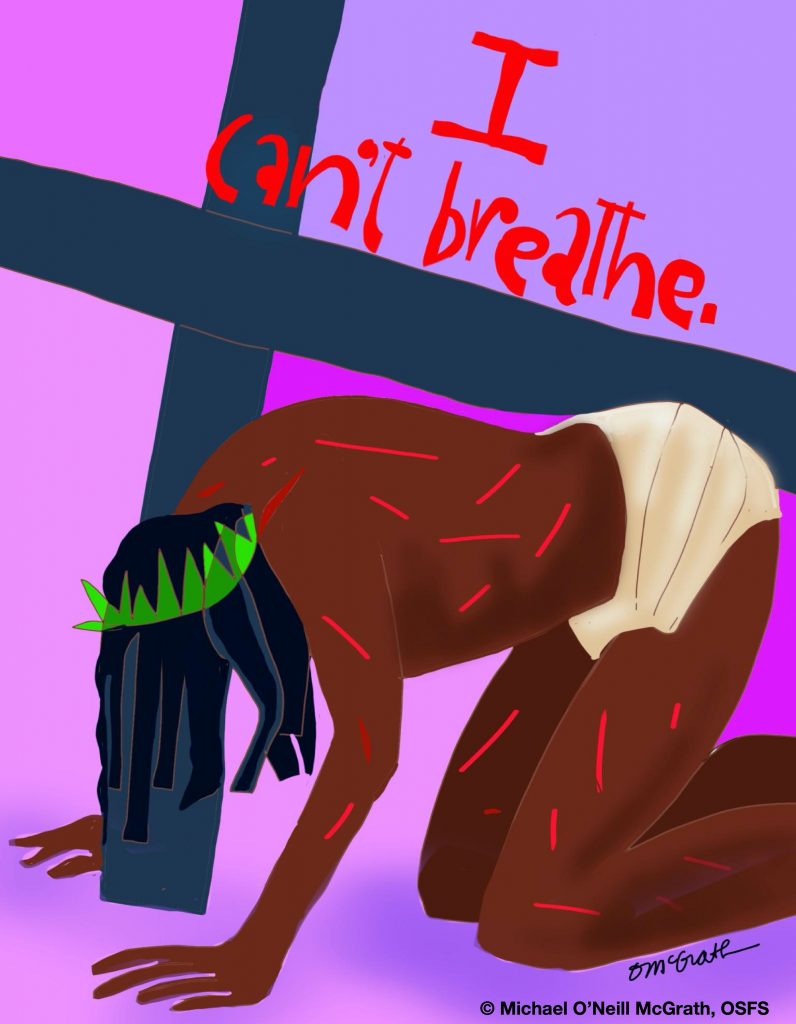In the early pages of the Bible, we read an ineffable profundity:
“So God created man in his own image,
in the image of God he created him;
male and female he created them.” (Genesis 1:27)
It’s difficult to say how much effort and ink has gone into traversing this mystery, but the basic meaning is plain:
God created man in his own image, not the other way ’round.
Reviewing this passage can help us evaluate contemporary art that features christological imagery. For example, last summer, on the heels of street violence associated with the George Floyd case, imagery was created and published widely featuring George Floyd as Christ.
A brief article provides insight into what creator, Mickey McGrath, was aiming for.
“If we could see Jesus as a black man falling under a cross, as a man who can’t breathe, maybe that will make people see him in others…”
When Mr. McGrath makes “Jesus as a black man”, he’s making Jesus in the image of a man (in this case, George Floyd). The proper ordering of creation has been reversed. Rather than seeing Floyd created in the imago dei (image of God), we find ourselves looking at the Savior of the World created in the image of Floyd. Jesus as imago hominis (image of the man).
This kind of “image reversal” is popping up at institutions with longstanding reputations for biblical fidelity . This past week, an art exhibit was displayed on the campus of BIOLA university and the similarities to McGrath’s work of last summer are undeniable.
The display of Jesus as imago hominis is one of many signs that we live in a postmodern culture. It is a loveless culture, intent on reversing, redefining, and ridiculing the sacred. The late philosopher and art critic, Sir Roger Scruton, explained the willful desecration of the sacred can be seen as the denial of love. He described it as an attempt to remake the world as though love were no longer part of it.
The Proverbs teach us, “Hatred stirs up strife, but love covers all offenses.” It’s difficult to deny that this type of imagery seeks to stir up offenses and keep them continually before our eyes. It that sense, it also reverses the purpose of art as it has been understood for millenia. Rather than point to the transcendent, eternal truths of redemption, these images demand the immediate past remain in the present.
Concluding thoughts:
Interestingly, McGrath is quoted toward the end of the article saying his life’s motto is a quote from Dostoevsky:
Beauty will save the world.
But beauty, on its own, cannot save anything. It points us to the One who can. Beauty points us to the living Christ, the God-man, who alone can provide redemption and hope in the midst of earthly pain. He is not a mere man to be shaped and molded into our own subjective interpretations. Christ does not bow to us, rather we prostrate ourselves before Him, worshipping Him for who He really is.
let it be known to all of you and to all the people of Israel that by the name of Jesus Christ of Nazareth, whom you crucified, whom God raised from the dead—by him this man is standing before you well. 11 This Jesus[a] is the stone that was rejected by you, the builders, which has become the cornerstone. 12 And there is salvation in no one else, for there is no other name under heaven given among men by which we must be saved.” (Acts 4:10-12)
If we desire to be faithful to Scripture, we cannot affirm Jesus as imago hominis in the arts. In all spheres, we must proclaim Him as the eternal Lord of Glory.

